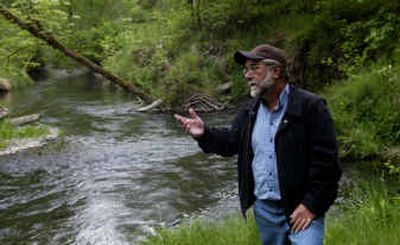Hatching salmon naturally

FORT LEWIS – People haven’t done many things right over the years at this steel-and-concrete pool, where finger-sized coho salmon wait for their journey to the sea.
At this hatchery and dozens like it around the Northwest, everything from the temperature of the water to the way the fish are fed has cut their chances of survival in the wild. Each year since 1977, more than a million young coho have swum out of hatcheries into the Nisqually River. Few ever returned.
The tribal managers who run the Clear Creek Hatchery are changing the way they do business, though, as part of an overhaul of the state’s hatchery system. By treating the hatchlings more like wild fish, they hope to improve their chances of survival.
The changes have little to do with a national proposal recently discussed to count hatchery fish in deciding if a salmon population needs Endangered Species Act protection. A Bush administration official told Congress Friday the government does not intend to substitute hatcheries for naturally spawning salmon in making those decisions. Nearly all of the troubled runs of West Coast salmon are expected to remain protected.
“We’re moving in our own direction — that is, toward having sustainable natural runs,” said David Troutt, natural resources director for the Nisqually Tribe.
Down a road lined with bright yellow blossoms of Scotch broom, at the chinook section of the hatchery, is something of an experiment. Though wild salmon have long been gone from the Nisqually River, which runs from Mount Rainier National Park to Puget Sound near Olympia, managers are trying to establish a population of fish that will survive and thrive on its own.
They have started treating hatchery chinook more like wild fish. In pools protected by netting, floating lattice that provides shade for the young salmon have made their coloring darker, which will help them better hide from predators. An $80,000 machine keeps the water cooler than in the past, limiting their size and making them less likely to dominate salmon hatched in the river.
And when it’s time for the fish to leave the hatchery, managers let them migrate down the creek and into the river at their own pace, ensuring that they’re mature enough to have a chance of surviving. Before, the chinook would all be scooped up and forced into the river at the same time.
It’s all designed to hone, rather than subvert, their instincts.
“Salmon have always been looked at in terms of nets, hooks and lines,” Troutt said. “We’re trying to change the way we look at salmon. It may be more labor intensive and more expensive, but it’s what’s best for the fish.”
Each year, the Clear Creek Hatchery releases about 3.4 million chinook. After a few years at sea, some 22,000 or so wind up getting caught by fishermen, and 8,000 to 10,000 return to the river to lay their eggs. Managers hope to see those numbers jump within the next few years, as the first salmon raised under the new measures begin to return.
That’s what has happened at a few experimental hatcheries in Washington run by an organization called Long Live the Kings, now in the eighth year of a 12-year project seeking to re-establish chum and chinook salmon runs on the Olympic Peninsula’s Hamma Hamma river.
The group’s hatcheries rear salmon in more natural ponds, with dirt floors, natural obstacles like branches and stones, and a lower fish density. Chinook returns in the Hamma Hamma have increased tenfold since the start of the project.
Barbara Cairns, the organization’s executive director, said it will be years before scientists can determine the long-term viability of such hatchery programs, but the indications are good.
And not only does the more natural rearing make the fish darker and less domesticated, she said: Biologists who tested salmon at the group’s Orcas Island facility found that they had higher levels of vitamin C than typical hatchery fish.
If the numbers of returning fish do climb at Clear Creek, they’ll cut back on how many hatchery fish they release, to keep from ruining the genetic pool of the returning salmon — a mistake hatcheries have made for generations as they shipped salmon eggs between rivers.
Similar changes are being considered or instigated throughout Washington’s century-old hatchery system, billed as the world’s largest. The hatcheries, managed by the state and Indian tribes, provide more than 70 percent of all salmon caught in Puget Sound and 90 percent of all salmon caught inland.
Over the past four years, a team of scientists appointed by Congress has evaluated the successes and failures of the system. Last month, the Hatchery Scientific Review Group released a hefty report calling for an overhaul that would place more emphasis on the needs of wild fish.
As a result, some unsuccessful hatcheries have been closed and entire hatchery-bred runs have been eliminated.
The Nisqually Tribe runs the Clear Creek Hatchery with permission from the Army because it’s on the Fort Lewis military reservation. Its $600,000 annual budget comes from Tacoma City Light, part of a settlement of a lawsuit against the utility for the damage its hydroelectric dams did to native salmon populations.